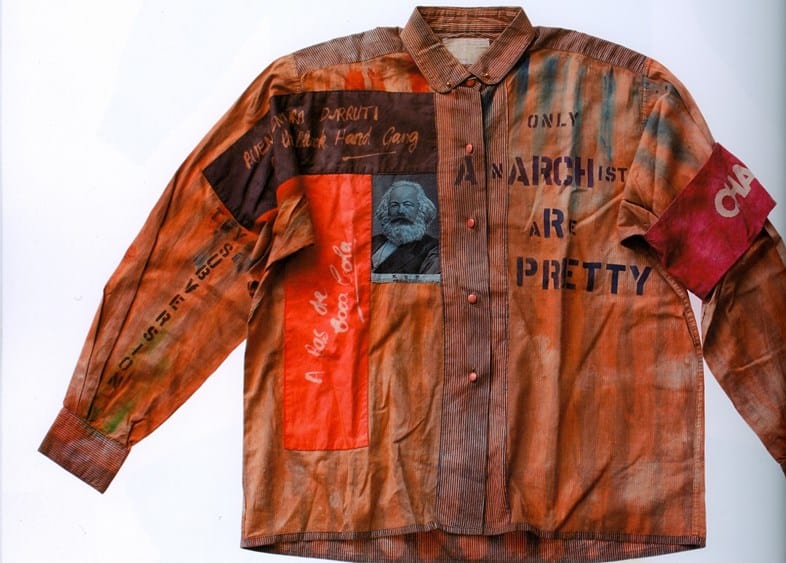Written by: Brianne Davis, Gallery Assistant
Patches are currently experiencing another trend revival, having experienced a rise in popularity a number of times, most notably throughout the 20th century. Today, everyone from Teen Vogue to the Huffington Post has written style articles about the comeback of patches. The intention behind patches has radically changed over the last century. Previously they were a primarily utilitarian item, mending clothes that were worn and torn and serving as an identifying feature on soldiers’ uniforms. With this latest reincarnation of patch fashion, it has to be considered how the era of fast fashion is effecting patches and the long running debate on handmade versus commercially produced.
As with many things, the Industrial Revolution changed the way that patches could be made and that changed how they are used. The ability to machine produce patches meant that they could then be made in large numbers. During the late mid-20th century, patches became a new medium for counter culture expression. In the 1970s, they became a popular way to spread slogans and a fashion statement that clearly set hippies apart from their corporate counterparts. A similar movement with patches was found during the 1980s and 1990s with the punk and grunge movements. Each group made patches to express their values and proudly proclaim their membership to the movement.

Vivienne Westwood and Malcolm McLaren, Anarchy Shirt, 1976. Source: Hiroshi Fujiwara Collection via dazeddigital.com
Though we are not currently in a completely dissimilar situation. Since the 1990s, when patches were last experiencing a popularity boom, we have entered a new era of clothing consumption. Current society is experiencing a phenomenon known as fast fashion. Fast fashion is “a marketing approach to respond to the latest fashion trends by frequently updating products with a short renewal cycle and turning the inventory at a rapid rate” (Byun & Sternquist 135). In many cases, this has further divorced patches from their highly individualized pasts. Previously patches were about individualism, either because they were one-of-a-kind handmade pieces or acted as a subscription to the countercultures of the 20th century. In many ways patches are still associated with individualism, selecting pieces and using them to create a mosaic to tell the story of who you are. The question is, how do you hold onto that individuality when millions of copies are being bought and sold?
The debate between handmade versus commercial production has been going strong, since the Industrial Revolution changed how we make most of our goods, and is one of the pieces of the Fine Craft world. As machines help us to make a multitude of perfect copies, it is the time and effort and limited number of each item that sets it apart. Scutelliphily is an exhibition of patches curated by Zoë Schneider at the Saskatchewan Craft Council Gallery. The show contains all handmade patches incorporating a wide variety of materials, such as felt, beads, thread, and fur. Each patch is a one-of-a-kind piece that highlights the different ways that we choose to adorn ourselves. In addition to the pieces installed, a DIY patch-making station is set up in the gallery. The station allows others to carry on the tradition of individual expression through patches, making their own custom piece.

Elizabeth Munro, Individuation: Ritual Dissent
So, what does it mean when one of the hallmark pieces that you use to proudly proclaim yourself among those in a counter-culture group becomes the piece dejour for the fashion world? The world of art, culture, and fashion have long found inspiration in the out groups, making what is out of fashion in. The foundations of patch culture will continue as the new catchy patches are churned out, and likely will produce handmade work in response to the new popularity of the medium. With demand for patches high, now is a great time for craftspeople making patches to gain attention for the skill and artistry that goes into handmade patches. After society at large has moved on from the trend, those that were a part of patch culture before will still be going strong.

References:
Byun, Sang-Eun and Sternquist, Brenda. “The antecedents of in-store hoarding: measurement and application in the fast fashion retail environment.” The International Review of Retail, Distribution and Consumer Research 2, no. 18 (2008): 133-147.
Lammerts van Bueren, Marjolein. “A brief history of the patch: from hippie to high-end fashion.” Amsterdam FashionWeek. 15 September 2016. Accessed: 8 April 2017. https://fashionweek.nl/en/article/15sep16-brief-history-patch-hippie-high-end-fashion.
Marzec, Kirby. “How to DIY Using Patches.” Teen Vogue. 2 September 2016. Accessed: 8 April 2017. http://www.teenvogue.com/story/how-to-diy-using-patches
Troy, Marcus. “Embroidered Patches Are Fashion’s Next Trend.” The Huffington Post. 15 August 2016. Accessed: 8 April 2017. http://www.huffingtonpost.com/marcus-troy/embroidered-patches-are-f_b_11429024.html
Images:
Elizabeth Munro, Individuation: Ritual Dissent, Source: Saskatchewan Craft Council.
Vivienne Westwood and Malcolm McLaren, Anarchy Shirt, 1976, Source: Hiroshi Fujiwara Collection via dazedigital.com. http://www.dazeddigital.com/fashion/article/16066/1/the-anarchy-shirt. (Accessed: 8 April 2017)
